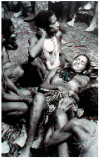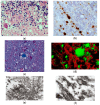Kuru, the First Human Prion Disease
- PMID: 30866511
- PMCID: PMC6466359
- DOI: 10.3390/v11030232
Kuru, the First Human Prion Disease
Abstract
Kuru, the first human prion disease was transmitted to chimpanzees by D. Carleton Gajdusek (1923⁻2008). In this review, we summarize the history of this seminal discovery, its anthropological background, epidemiology, clinical picture, neuropathology, and molecular genetics. We provide descriptions of electron microscopy and confocal microscopy of kuru amyloid plaques retrieved from a paraffin-embedded block of an old kuru case, named Kupenota. The discovery of kuru opened new vistas of human medicine and was pivotal in the subsequent transmission of Creutzfeldt⁻Jakob disease, as well as the relevance that bovine spongiform encephalopathy had for transmission to humans. The transmission of kuru was one of the greatest contributions to biomedical sciences of the 20th century.
Keywords: Carleton Gajdusek; Kuru; neuropathology; prion diseases.
Conflict of interest statement
The authors declare no conflicts of interest.
Figures
















Comment in
-
Comment on Liberski, Gajos, Sikorska, and Lindenbaum: "Kuru, the First Human Prion Disease" Viruses 2019, 11, 232.Viruses. 2020 Mar 5;12(3):284. doi: 10.3390/v12030284. Viruses. 2020. PMID: 32150831 Free PMC article.
References
-
- Asher D.M., Gibbs C.J., Jr., Sulima M.P., Bacote A., Amyx H., Gajdusek D.C. Transmission of human spongiform encephalopathies to experimental animals: Comparison of chimpanzee and Squirrel monkey. In: Brown P., editor. Transmissible Spongiform Encephalopathies—Impact on Animal and Human Health. Volume 80. Karger; Basel, Switzerland: 1993. pp. 9–13. - PubMed
Publication types
MeSH terms
Substances
LinkOut - more resources
Full Text Sources

